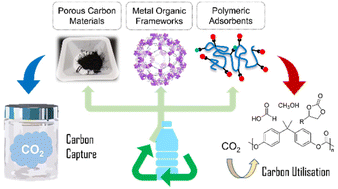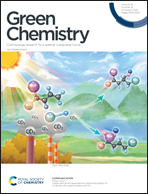Materials from waste plastics for CO2 capture and utilisation
Abstract
Anthropogenic activities have resulted in a sustained increase in atmospheric CO2 levels over the past 200 years. To mitigate this, materials capable of capturing or chemically transforming CO2 have received tremendous attention recently. However, porous materials such as polymeric adsorbents and metal–organic frameworks (MOFs), which have demonstrated considerable success in carbon capture and utilisation, are traditionally synthesized from non-renewable petrochemical feedstock. In line with recent trends towards a circular materials economy, there have been greater emphases on functional materials design and production from societal waste. Therefore in this Perspectives article, we highlight and discuss the possibility of using waste commodity plastics as hitherto-overlooked low-cost alternative resources for the synthesis of functional materials for CO2 capture and utilisation. This not only reduces the quantity of waste plastics disposed, but also offers a second lease-of-life to these polymers by keeping them in continuous use. Herein, we examine how the polymer structures of commodity plastics have influenced the design of the resulting carbon nanomaterials, polymeric adsorbents and MOFs for effective CO2 capture and conversion into useful chemicals, such as cyclic carbonates. With this field currently only in its infancy, we also discuss the limitations of the current work, our opinions on further exploiting the potential of waste commodity plastics for CCU applications, and the essential considerations involved in this multidisciplinary endeavour.

- This article is part of the themed collection: Green Chemistry Reviews


 Please wait while we load your content...
Please wait while we load your content...